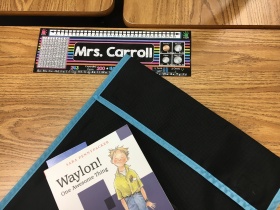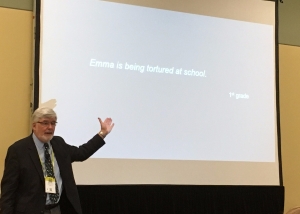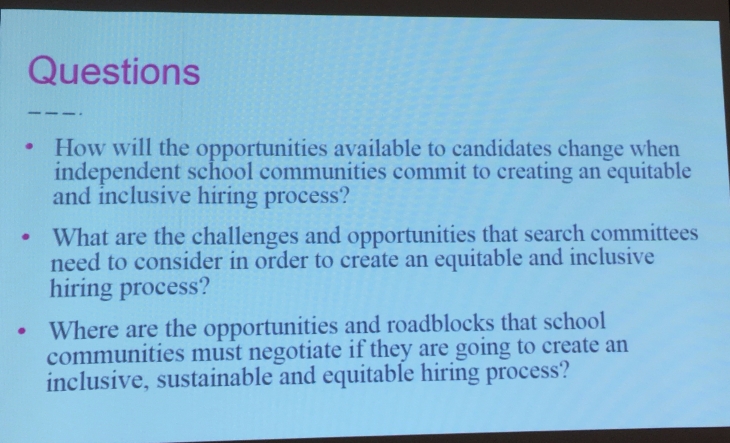This year, for my #ShadowaStudentDay, I became a fourth grader. Once again, being a student was exhausting and incredibly rewarding at the same time.
I stopped by the fourth grade classroom the afternoon before my visit to check on my homework so I was prepared for the day. I had to read the first two chapters of Moby Dick (Junior Classic), complete some addition of mixed number math practice, and prepare some spelling materials. I was excited about the reading since the students were just getting started on a new book.
I also got a sneak peek at the 4th Grade’s Thursday schedule. I thought to myself — I better get a good night’s sleep!

Here are some observations/highlights from my day:
1) Having a clean and organized desk in fourth grade is absolutely necessary for the multiple transitions throughout the day. Students were given 10 minutes to tidy up and organize at the start of the day. I had some helpful classmate give me some tips! It set me up for success!

2) Our morning meeting and greeting was calm and set a great tone for the day. We did some word puzzles to get our mind working. The fourth graders were very welcoming to their new ‘classmate’ and asked if they could call me Lorri. I thought it best that we keep it at Mrs. Carroll. They were super cute about it. 🙂
3) I loved Reading class! Digging into new characters (“Call me Ishmael!” ), making lists of character traits, inferring what the author meant in his writing — I miss this and it made me want to join a book club. What a great discussion about how unfair it is to judge people by the way they look. This time FLEW by!
Side note: I had a hard time stopping after two chapters the night before. I can imagine this is even harder as you get deeper into the book.
4) Fourth graders are trusted to work with matches! And, they did so responsibly in science class. We completed an awesome lab on gasses. The students loved it.
5) Time is tight in fourth grade and there is no time to waste! After science, we had a “working snack,” where students navigated stations. This was planned masterfully by my teacher, Mrs. Dixon. She called off different groups giving them the direction of what they should be doing: illustrating character traits from Moby Dick, working on spelling, working on vocabulary, or reading to self. During this block of time, Mrs. Dixon worked on personalized, directed spelling lessons with two of the groups. An impressive fete, for sure! Each group of students had different spelling words that met their needs, including me! For the record, I had a very hard list from the Derivational Spelling Stage. I had to sort these words and do some activities with them. I still can’t spell bureaucracy.
Then, I moved to the vocabulary activity. I was bummed that I didn’t have time to read my book of choice but Mrs. Dixon reminded all of us that we would have more time for stations later on.
6) Energizers are less popular in fourth grade. I got the sense that all the students really wanted to participate in the movement activity but didn’t want to look “uncool.” Only 6 or 7 did. Very interesting. It made me a little sad. Of course, I didn’t care and jumped around with SpongeBob and it made me feel refreshed and ready to work again.

7) Writing is fun and most kids loved it! During Language Arts, students got right to work on revising their opinion stories or adding an introduction/ conclusion. Students seemed to know exactly what they needed to work on. Mrs. Dixon conferenced with students who needed some additional support. I enjoyed getting started on mine!

8) While I am not the best artist, I still enjoy drawing and coloring! Our assignment was to illustrate a silly poem/song in preparation for Alan Katz’s visit to our school next week. I chose the one about a student who had a very overdue library book. I liked how we were asked to discuss our work with a classmate and offer compliments and suggestions.

9) During Social Studies, I had a flashback of being in 4th grade with Mrs. Ross in 1979. Students were in the midst of a unit on government. There was a quick review of the three branches but then we watched “How a Bill Becomes a Law” and completed a fun, group activity with it. So awesome that “Schoolhouse Rock” is still as loved now as it was back then!
10) Listening to the little conversations between peers during math was awesome! That’s where you can tell learning is happening. “Wow. This seems easy now.” “I can’t believe I couldn’t get this yesterday.”

Conclusions:
Even after the desk cleaning/organizing earlier in the day, it was amazing how many students misplaced materials in what seemed like the bottomless pit of a fourth-grade desk! This is an important skill and we need to keep having students work on it.
After my 3 days of soreness after last year’s 2nd grade PE class, I was smart enough to pick a day when 4th grade didn’t have PE. It was interesting, though, that on a “normal day” for me, I usually have about 10,000 steps by 3pm. When I was a fourth grader, I had 6,045 instead. Need to find a way to add more activity!
Desks are still uncomfortable to sit in for extended periods of time and I was grateful for the movement around the 4th-grade classroom. Students made use of all the spaces with ease and comfort. Need to keep working on options.
This was the easiest year to be without my phone. I took it out to take a few pictures but resisted all urges to check and answer email.
Once again, I cannot stress the valuable experience of walking the walk of a student for an entire day. I thoroughly enjoyed my day and I thank all my teachers and classmates for welcoming me!











 turns, eye contact, speaking clearly, self reflection, listening…I could go on and on! Loved the dice greeting.
turns, eye contact, speaking clearly, self reflection, listening…I could go on and on! Loved the dice greeting. 4) Choices are good and the kids really embraced having them. “Word Work” (my choice) wasn’t your boring 2nd grade daily spelling activities from 1978!
4) Choices are good and the kids really embraced having them. “Word Work” (my choice) wasn’t your boring 2nd grade daily spelling activities from 1978!


 As part of the graduate school course I took this summer in Fairfield University’s
As part of the graduate school course I took this summer in Fairfield University’s  VOICE: Tone and tenor of the piece — the personal stamp of the writer, which is achieved through a strong understanding of purpose and audience. Use a highlighter to show students where their voice is starting to come through.
VOICE: Tone and tenor of the piece — the personal stamp of the writer, which is achieved through a strong understanding of purpose and audience. Use a highlighter to show students where their voice is starting to come through.



 Day 2 at NAIS began with a fantastic session entitled “Parents Who Insist Their Child Is Being Bullied (Even Though the School Doesn’t See It)” with Michael Thompson, Psychologist and Daisy Pellant (Breck School – MN).
Day 2 at NAIS began with a fantastic session entitled “Parents Who Insist Their Child Is Being Bullied (Even Though the School Doesn’t See It)” with Michael Thompson, Psychologist and Daisy Pellant (Breck School – MN).
 Wise (Seacrest School – CA), and Laura Blackburn Reed (NCAIS) facilitated a workshop that invited conversation and action-planning to “build a deeper understanding of the variables at the intersection of gender and culture in independent schools.”
Wise (Seacrest School – CA), and Laura Blackburn Reed (NCAIS) facilitated a workshop that invited conversation and action-planning to “build a deeper understanding of the variables at the intersection of gender and culture in independent schools.”










 Day 1 of #NAISAC began with an engaging session with Barry Gilmore (Hutchinson School – TN), Matthew Rush (Allen Academy- (TX), Michelle Alexander (Cannon School – NC).
Day 1 of #NAISAC began with an engaging session with Barry Gilmore (Hutchinson School – TN), Matthew Rush (Allen Academy- (TX), Michelle Alexander (Cannon School – NC).
 I love the excitement and anticipation before attending a conference, especially
I love the excitement and anticipation before attending a conference, especially  session is not meeting your needs, you have a backup plan. Attending EdCamps helped me realize my time is too precious at conferences like this to waste them in a session that is not meeting my needs.
session is not meeting your needs, you have a backup plan. Attending EdCamps helped me realize my time is too precious at conferences like this to waste them in a session that is not meeting my needs. many levels.
many levels.